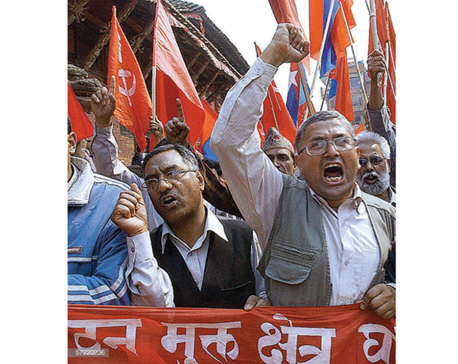
OR
What will South Asia look like after the pandemic?
Published On: September 18, 2020 05:47 PM NPT By: Valerie Mercer-Blackman and Jagadish Prasad Bista


Valerie Mercer-Blackman and Jagadish Prasad Bista
Mercer-Blackman is a Senior Economist at the WBG’s South Asia Office of the Chief Economist, currently focusing on policy-based research and regional trends in South Asia. Bist is a Kathmandu-based freelance researcher and writes on finance, economics and sociopolitical matters.news@myrepublica.com
More from Author
Some of the knock-on effects on the economy are yet to be felt, and in most countries in South Asia we are not yet out of the first wave of the pandemic.
The Covid-19 pandemic is testing every aspect of the poverty fabric in South Asia: it’s the double whammy of a severe economic catastrophe and an unprecedented health crisis at the base of the income pyramid. While people in the middle of the pyramid are losing their jobs, people at the bottom experience poverty, hunger and malnutrition. South Asian countries are already at the lower end of the Global Hunger Index (Sri Lanka ranking the highest at 66th and Afghanistan the lowest at 108th out of 117 countries). Most of the region’s urban population works in the informal sector and is heavily dependent on daily wages for survival.
What are the ways in which this pandemic will push more South Asians into extreme poverty?
According to the World Bank, South Asia is likely to experience the worst economic performance of the last 40 years in 2020. This will come through a stifled tourism industry, heavily disrupted supply chains, disrupted international demand for garments and other manufacturing goods, a deteriorated consumer and investor sentiment and tapering remittance inflows.
In manufacturing, about 170 million blue-collar workers alone in India have been directly affected by the governments’ lockdown due to the Covid outbreak. In Bangladesh, textile and garments workers will face dire consequences of declining global demand for textiles and garments, which account for about 81 percent of global exports. The conditions are similar in Sri Lanka—with almost 40 percent of exports concentrated in a few manufacturing sectors, with textiles and garments having the largest share. In Pakistan, 54 percent of manufacturing exports are related to the textile and garments, food, beverages, and tobacco sub-sectors. The World Bank report estimated that one in four households with income from the manufacturing sector is already poor.
Urban services sectors and tourism have been affected particularly badly by the lockdown given the large employment share of 20 percent, such as the hospitality and retail sectors. Consumption in these sectors tends to be much less affected during downturns, but this time around they have borne the brunt, with a significant number of livelihoods at stake. In the Maldives, the tourism and related industries account for two-thirds of GDP. The sector’s standstill has left many people unemployed and will lead to a drop in more than 80 percent of GDP as estimated by the World Bank. In fact, the whole region is likely to have dire long-term consequences of a prolonged shutdown in tourism. The regional poverty rate is expected to increase as households close to the poverty line would likely fall into poverty due to the loss of income sources.
Similarly, returning overseas migrant workers from abroad have led to estimates that remittances could decline by 22 percent, compounding rural poverty in most countries. About 40 million South Asians are based overseas. Countries such as Nepal, where remittance inflows are over a quarter of GDP, will suffer the most. Though Nepal has remarkably decreased its poverty rate during the past decade, the current pandemic is likely to push about 31.2 percent of the population that are estimated to live between $1.90 and $3.20 a day to extreme poverty. Cases are similar with other countries in South Asia; they have faced inflow of millions of migrant workers triggering the higher rural poverty.
An equally important income source for rural households is related to internal migration. The lockdown has affected hundreds of millions of migrants across the subcontinent, many of whom are day laborers and no longer have work opportunities in urban centers.
Lack of food security and disposable income will continue to risk livelihoods going forward. According to the World Bank, in Afghanistan, nearly 14.3 million people are projected to be in crisis because of food insecurity as a result of lockdowns. In Pakistan, India, Nepal and Bangladesh, with high levels of food insecurity and widespread malnutrition among children, the consequences of the virus spreading widely could reverse the recent positive trends in poverty and prove to be catastrophic and far reaching.
Some of the knock-on effects on the economy are yet to be felt, and in most countries in South Asia we are not yet out of the first wave of the pandemic.
Therefore, amidst shrinking GDP, economies should work on policies to reduce the macroeconomic shocks and shore up private sector activity. There are two main areas of concern going forward, and the faster governments get a grip on these, the lower the long-term damage. This is in the spirit of taking advantage that the crisis is an opportunity to strengthen institutions.
First, for countries most dependent on remittances (Nepal, Bangladesh and Afghanistan), this is an opportunity to expand and empower their overseas worker ministries or agencies, by helping potential migrants get information about availability so they do not depend on hiring agents, enhance digital payment systems and work with host countries to ensure that they can return to work there under better conditions. Overseas migrant workers are a tremendous asset to host countries. A good example to learn from is the Philippines.
On the domestic front, banks will need continued liquidity injections from central banks and close collaboration with regulators to ensure that non-performing loans remain at manageable levels. This is particularly true for the RBI, as a financially sound India will create positive spillovers to the rest of South Asia. Moreover, it will allow governments to focus on supporting the recovery: loans to small and medium-sized enterprises and microenterprises—which tend to be more informal in nature and are more likely to benefit the poor—are also more difficult to target through monetary policy. Instead, fiscal programs that increase transfers to households and very small businesses, as well as employment creation programs should be the current overriding focus of South Asian governments.
Mercer-Blackman is a Senior Economist at the WBG’s South Asia Office of the Chief Economist, currently focusing on policy-based research and regional trends in South Asia. Bist is a Kathmandu-based freelance researcher and writes on finance, economics and sociopolitical matters.
You May Like This

‘Love in the Time of Corona’ is ‘time capsule’ of the times
From grappling with big life decisions to a marriage on the brink, a new four-part miniseries tackles relationship struggles during... Read More...

Testing times for India in race to head off coronavirus epidemic
NEW DELHI, April 6: India, like a lot of countries plunged into crisis by the pandemic, is struggling to ramp up... Read More...

Understanding Kautilya to design Nepal’s security
Complying with the geo-political reality in South Asia, the Great King Prithvi Narayan Shah in the late 18th century appropriately... Read More...







Just In
- NRB to provide collateral-free loans to foreign employment seekers
- NEB to publish Grade 12 results next week
- Body handover begins; Relatives remain dissatisfied with insurance, compensation amount
- NC defers its plan to join Koshi govt
- NRB to review microfinance loan interest rate
- 134 dead in floods and landslides since onset of monsoon this year
- Mahakali Irrigation Project sees only 22 percent physical progress in 18 years
- Singapore now holds world's most powerful passport; Nepal stays at 98th











Leave A Comment